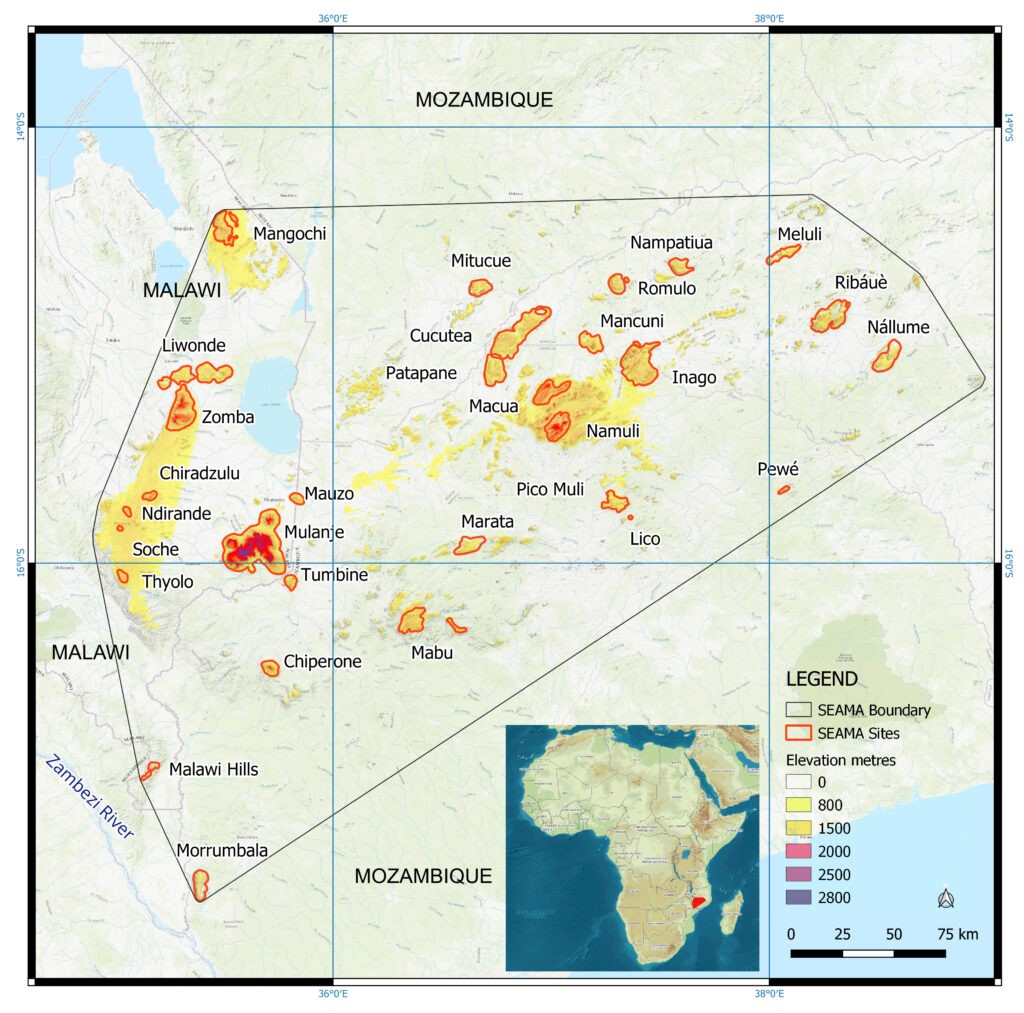Description

Disclaimer: Copyright infringement not intended.
Context:
Recent biological surveys of ancient inselbergs in southern Malawi and northern Mozambique have led to the discovery and description of many species new to science, and overlapping centres of endemism across multiple taxa.
Details:
South East Africa Montane Archipelago’ (SEAMA)
- The ‘South East Africa Montane Archipelago’ (SEAMA) as a distinct ecoregion of global biological importance.
- The mountainous SEAMA stretches across northern Mozambique to Mount Mulanje in Malawi, southern Africa’s second highest mountain.
- The ecoregion encompasses 30 granitic inselbergs reaching > 1000 m above sea level, hosting the largest (Mt Mabu) and smallest (Mt Lico) mid-elevation rainforests in southern Africa, as well as biologically unique montane grasslands.
- SEAMA has distinctly higher annual rainfall and humidity, especially in the dry season, compared to surrounding regions.
A threatened ecoregion
- Despite its ecological significance, SEAMA faces severe deforestation threats, highlighting the urgent need for conservation initiatives.
- Since 2000, it has lost 18 per cent of its primary humid forest cover (up to 43 per cent in some sites) — one of the highest deforestation rates in Africa.
- The major cause of montane forest loss in SEAMA is slash and burn shifting agricultural practices, typically used for subsistence food production by local communities, along with charcoal production, for household cooking and as a source of revenue (sold on for use in urban areas).
- Conservation agriculture practices and sustainable alternative livelihoods are required to address these threats throughout SEAMA ecoregion.

Survey regions
- The most comprehensively surveyed site in Malawi is Mount Mulanje, followed by Mangochi, Ndirande, Soche and Thyolo.
- In Mozambique, the most extensively and holistically studied sites are Mabu, Namuli and Lico. As many as nine Mozambique sites have never been scientifically surveyed.
Findings
- The researchers recognised at least 30 sites (nine in Malawi, 21 in Mozambique) in the core of the SEAMA ecoregion.
- The study documents 127 plants, 45 vertebrates (amphibians, reptiles, birds, mammals) and 45 invertebrate species (butterflies, freshwater crabs) as well as two endemic genera of plants and reptiles.
- There are 22 strictly endemic reptile species. Of these, 19 are forest-dependent and the others occur mainly in upland grasslands and on rock faces. As they predominantly occur in forests, SEAMA’s endemic reptiles are highly threatened by habitat loss.
Ecological regions
- Ecological regions (ecoregions) are widely used to inform global conservation priorities.
- They define large expanses of land or water, characterised by geographically distinct assemblages of animals and plants.
- New ecoregion definitions are rare, and typically follow many years of research across a range of scientific disciplines.
|
Inselberg
An inselberg is one of the landforms resulting from erosional processes. For an inselberg to form, there has to be pronounced variations in the level of weathering of the land surface. Inselbergs arise from rocks which erode at a slower rate than that of the surrounding rocks. The landform consists of an erosion-resistant rock which protects a softer rock such as limestone. The resistant rock remains isolated as ongoing erosion erodes the less resistant rock around it. Volcanic processes are responsible for the rising of the resistant rock above the surrounding area. The resistant rock is able to resist erosion due to its tight joints. Once formed, inselbergs appear steep sided. Over time, inselbergs may be destroyed through the marginal collapse of exfoliation sheets and joint blocks. A massive inselberg is referred to as a bornhardt which manifests as dome-topped, bare, and steep-sided.
|

Conclusion
These findings prompted further surveys of other mountains in the region and resulted in new species descriptions, including many from Mount Mabu, which is now recognised to be the most extensive mid-elevation rainforest in southern Africa.
|
PRACTICE QUESTIONS
What are the main threats to biodiversity across the world? How can the concept of biodiversity hotspots help in conserving the rich and diverse flora and fauna of the country? (250 words)
|












